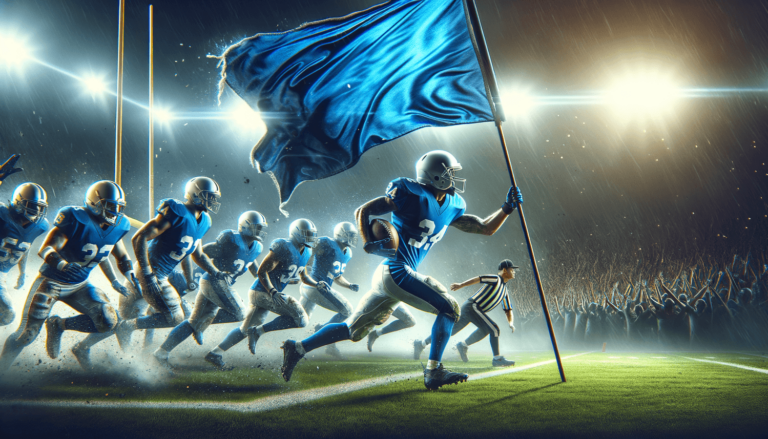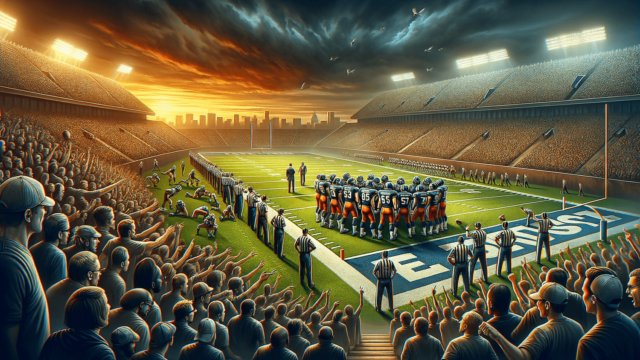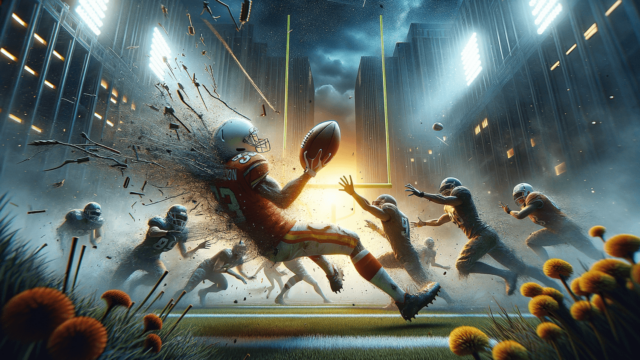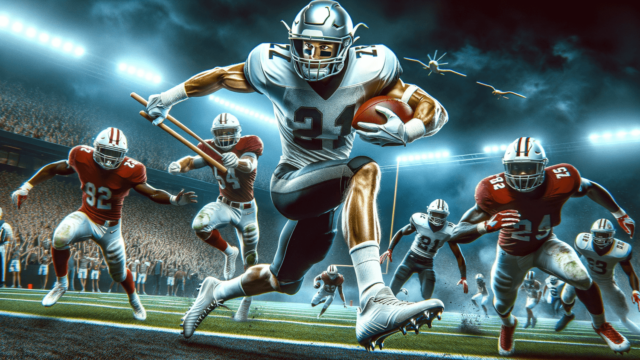
In football, a blue flag usually represents a “fair catch signal”, indicating that the player catching the ball will not attempt to advance it after receiving a kick or punt, and the play will end immediately. By raising a hand and waving a blue flag, the player is essentially asking for a fair catch, preventing the opposing team from tackling them while also foregoing any opportunity to advance the ball.
Understanding the Blue Flag in Football
The blue flag in football serves as a symbol for a “fair catch signal.” It is an essential aspect for both players and spectators, as it creates a safe and strategic environment while playing the game. The primary purpose of the blue flag is to ensure the safety of the player receiving the ball, without compromising the legitimacy of the game.
How and When to Use the Blue Flag
When receiving a kick or punt, the player can raise a hand and wave the blue flag to indicate they will not attempt to advance the ball after catching it. At this point, the play will end immediately, and the opposing team cannot tackle the player. However, the player also gives up the opportunity to advance the ball. This strategic move can be beneficial in various situations, such as when the receiver is surrounded by opponents or when there is a high risk of fumbling the ball.
The Rules Governing the Fair Catch Signal
There are specific rules that regulate the use of blue flags and fair catches in football. For instance, the signal must be clear and unambiguous – it must be a visible arm movement above the player’s head, with the blue flag waving back and forth. Furthermore, once the fair catch signal has been made, the player must catch the ball without making any attempt to advance it down the field. Lastly, the opposing team must provide the player enough room to make the catch without interference; failing to do so can result in a penalty.
Impact on the Game and Strategy
Using the blue flag for a fair catch can significantly impact the game and the team’s strategy. By opting for a fair catch, the player avoids the risk of getting tackled, injured, or losing the ball. The team can then start their offensive play from that spot without any significant loss. However, this decision also means that the player forfeits their chance to make any additional yardage on that particular play, which could be a significant setback depending on the game situation. Therefore, players and coaches must weigh the risks and advantages before utilizing the blue flag and fair catch mechanism.
History of the Fair Catch Rule
The fair catch rule has a long history, dating back to the early days of American football in the late 19th century. The rule was initially introduced to promote player safety and decrease the likelihood of injury, especially during the often-chaotic punt return process. Over time, the rule has evolved and been refined to its current state, still holding player safety as its primary objective.
Common Misconceptions about the Blue Flag
Many people, even some avid football fans, may not be aware of the true meaning of the blue flag or may confuse it with other colored flags used in the sport. For example, some assume the blue flag is related to penalties or official calls by the referee. However, a yellow flag is used for penalties, while a red flag is used for coaches’ challenges. The sole purpose of the blue flag is to indicate a fair catch signal.
Benefits and Drawbacks of the Fair Catch
There are both pros and cons associated with requesting a fair catch by waving the blue flag:
Benefits:
- Player safety: The primary advantage is the protection of the player from being tackled and a reduced risk of injury.
- Ball security: A fair catch eliminates the possibility of fumbles or muffed punts which could result in a turnover.
- Game management: Calling for a fair catch allows teams to regroup and strategize before their next offensive play.
Drawbacks:
- Lost opportunity: By opting for a fair catch, the returner misses out on the chance to gain extra yardage during the return.
- Predicibility: Savvy opponents may be able to anticipate a fair catch if the receiving team uses it too frequently.
- Outcome dependency: A fair catch depends heavily on the accuracy of the kick and the distance between returner and defenders.
Additional Fair Catch Situations
Although the most common use of the blue flag is for regular kick and punt receptions, there are a few additional situations in which a fair catch is allowed:
- Free kick after a safety: In this case, the receiving team can still call a fair catch using the blue flag, following the same rules as regular punts.
- Missed field goal returns: If the ball remains in play, the receiving team has the option to signal for a fair catch; this is rare but possible in specific situations.
FAQ Section: Blue Flag and Fair Catch in Football
In this FAQ section, we address some common questions related to the blue flag and fair catch rule in football, providing deeper insights into the concept and its impact on the game. Discover the answers to these popular queries and enhance your understanding of this strategic play.
What happens if the player drops the ball after signaling a fair catch?
If a player signals for a fair catch but subsequently drops the ball, it is considered a live ball and can be recovered by either team. This is known as a “muffed punt” and can be a risky proposition for the receiving team as it may lead to a change in possession.
How much room must the opposing team give a player signaling a fair catch?
According to the rules, players on the opposing team must give the receiving player at least one yard of space to catch the ball. Not providing adequate space can result in a penalty called “kick-catching interference,” which awards the receiving team extra yardage.
Can the fair catch rule be utilized in other forms of football, such as college or high school games?
Yes, the fair catch rule is applicable across various levels of American football, from professional leagues like the NFL to college and high school games. The rule implementation might vary slightly depending on each league’s specific regulations, but the core concept remains consistent across all levels.
What are the consequences for making a fake fair catch signal?
If a player attempts to deceive the opposing team by faking or simulating a fair catch signal, the officials can penalize the receiving team for “invalid fair catch signal.” This penalty results in a loss of yardage and undermines the player’s intention of gaining an unfair advantage.
Are there any exceptions or unique circumstances where a fair catch cannot be called by waving the blue flag?
Generally, a fair catch cannot be called if the ball touches the ground or an opposing player before reaching the intended receiver. In these cases, the ball becomes live, and the returner must play it as a regular kick or punt return, without the protective benefits of a fair catch.
Featured Posts
- No pillar pages found.





